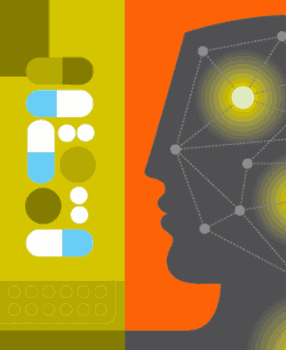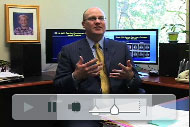SUMMER 2008 CONTENTS
Home
Good as Gold?
New drug approvals ebb; doubts over testing's gold standard grow
Q&A with Katie Couric
Standing up for cancer research
Breath of Hope
Lifeline or gamble? Sometimes a clinical trial is both
Just Another Lab Rat
The human subjects trade is booming, largely without oversight
Fixing Trial Tribulations
Solutions from Stanford
A Spoonful of Sugar Pills
Why nothing really is something, and in some ways is better than anything
Banding Together
Minds of all kinds join to hasten discoveries of new medical treatments


A Spoonful of Sugar Pills
Why nothing really is something, and in some ways is better than anything
By Mitzi Baker
Illustration by Paul Wearing
The placebo effect at its simplest is an effect
produced by
nothing.
That “nothing” is usually some kind of fake treatment. It could be a pill containing an inactive substance such as sugar, an intravenous drip of saline solution or even holes drilled in the head for sham surgery. More subtle aspects of the placebo effect include what color a pill is, how much patients trust their doctors and, as Stanford associate professor of marketing Baba Shiv, PhD, and his colleagues have recently shown, the supposed price of the drug (the higher, the better).
The placebo effect perplexes patients, confounds clinicians and thwarts drug developers. It has been documented in the medical literature for more than a century, and anecdotally for thousands of years. Yet until the last decade or so, modern medicine has considered it largely a nuisance — an annoyance to account for when designing clinical trials. But now scientists armed with results of new imaging studies are beginning to harness the effect for the additional boost it can provide for therapy.
Shiv and various others interested in the placebo effect have turned to MRI scans of the brain to witness the interplay between mind and body. A group at the University of Michigan has found that MRI studies indicate that the placebo effect alters the brain’s interpretation of the body’s signals. At Stanford, associate professor of anesthesia Sean Mackey, MD, has taken this idea one step further and figured out how people can control the regions in the brain activated by the placebo effect to reduce pain.
Mackey’s team allowed chronic pain sufferers to see their brain activity in real time inside an MRI scanner, and the subjects used various mental strategies to try to calm the activity in one of the pain centers of the brain, the rostral anterior cingulate cortex. This region, which is active when a person receives a placebo, wraps around the corpus callosum — the fibrous bundle that relays neural signals between the right and left hemispheres of the brain. Over time, subjects developed the ability to dampen activity in this part of their brains, reducing their impression of pain.
“What we are doing with MRI is using laser beam-like focus and controlling specific brain centers associated with our perception of pain and turning it down right at the source,” says Mackey, who also directs the Stanford Pain Center. “We may ultimately be super-charging the same systems involved in placebo.”
Mackey’s group has learned a lot about which parts of the brain respond to the placebos. Now he and his colleagues are trying to tease apart the subtleties of the response: Why do some people have a very large placebo response and others don’t? Ultimately he wants to know: “How can we harness the placebo response to do good?”
Currently, it isn’t possible to easily or cheaply examine one’s own brain waves. And, says Mackey, “We can’t prescribe a placebo. That ultimately falls under deception, and the FDA frowns upon that.”
But a more immediate application might be simply acknowledging that a patient’s belief and expectation in a medical setting account for much of the healing power of the placebo.
Psychiatrist David Spiegel, MD, the Jack, Lulu & Sam Willson Professor in the School of Medicine, has extensively studied how psychosocial factors affect the brain’s response to pain and illness. “The placebo effect gets to the idea that we are social animals, and it can tell us a lot about the doctor-patient relationship,” says Spiegel, who contends that the current emphasis on doctors spending less time with patients and over-reliance on medications and procedures might be “penny-wise and pound-foolish.”
Spiegel notes a study that found that a side effect of cancer chemotherapy — lowered white blood cell counts — already kicks in when patients arrive at the hospital, even before they receive their next treatment. The patients and their bodies were expecting an effect, and their immune cells complied. “That means part of the response to a drug results from conditioning in addition to any direct pharmacological effect,” says Spiegel. In this case, chemotherapy kills rapidly dividing cells: both cancer cells and white blood cells. While a low white blood cell count is a side effect, the same principle applies to therapeutic effects. So if a patient’s confidence in the drug grows, conditioning might reinforce its physiological effects. Spiegel wonders: Would those patients be better off if physicians gradually lowered their doses as the placebo effect intensified?
Mackey points out that he actually uses the placebo effect all the time, maximizing its power by making it clear to patients that he believes in the drug or procedure and cares about their progress. And a patient who feels better is more likely to exercise and go to physical therapy, activities that are hard to start when in chronic pain. “How we present information to patients plays a huge role in the ultimate benefit that a patient will get out of a therapy, so we harness that all the time,” says Mackey. “It’s a double whammy to combine the pharmacological effects with the placebo effect — then we have a real winner.” The danger is setting expectations too high, which would likely result in a disappointed, frustrated patient.
Mackey even uses the placebo effect on himself. He’s convinced that taking zinc and the herb echinacea has drastically reduced the number of colds he gets each year. As for the scientific evidence, it’s irrelevant. “I’m a big believer in it,” he says. “Is it because the placebo effect is having an impact on my immune system? Maybe. But you know what, if it’s just the placebo effect, I’m OK with that.”

Video extra
Sean Mackey discusses the placebo effect on the brain.


